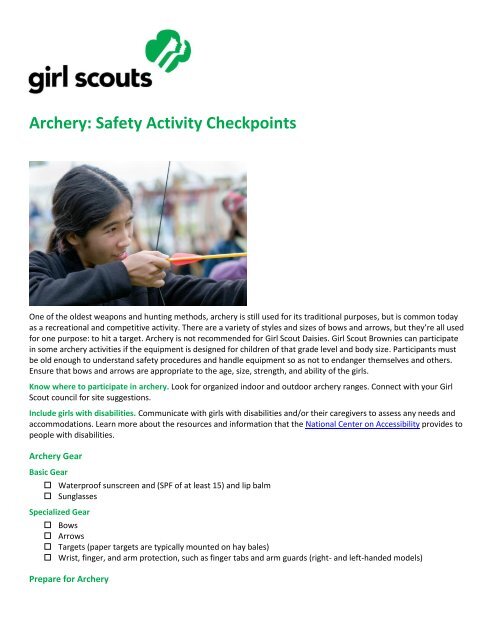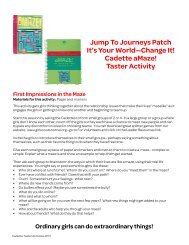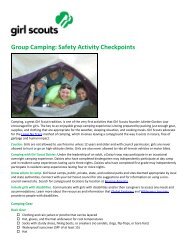Archery: Safety Activity Checkpoints - Girl Scouts of
Archery: Safety Activity Checkpoints - Girl Scouts of
Archery: Safety Activity Checkpoints - Girl Scouts of
You also want an ePaper? Increase the reach of your titles
YUMPU automatically turns print PDFs into web optimized ePapers that Google loves.
<strong>Archery</strong>: <strong>Safety</strong> <strong>Activity</strong> <strong>Checkpoints</strong>One <strong>of</strong> the oldest weapons and hunting methods, archery is still used for its traditional purposes, but is common todayas a recreational and competitive activity. There are a variety <strong>of</strong> styles and sizes <strong>of</strong> bows and arrows, but they’re all usedfor one purpose: to hit a target. <strong>Archery</strong> is not recommended for <strong>Girl</strong> Scout Daisies. <strong>Girl</strong> Scout Brownies can participatein some archery activities if the equipment is designed for children <strong>of</strong> that grade level and body size. Participants mustbe old enough to understand safety procedures and handle equipment so as not to endanger themselves and others.Ensure that bows and arrows are appropriate to the age, size, strength, and ability <strong>of</strong> the girls.Know where to participate in archery. Look for organized indoor and outdoor archery ranges. Connect with your <strong>Girl</strong>Scout council for site suggestions.Include girls with disabilities. Communicate with girls with disabilities and/or their caregivers to assess any needs andaccommodations. Learn more about the resources and information that the National Center on Accessibility provides topeople with disabilities.<strong>Archery</strong> GearBasic Gear Waterpro<strong>of</strong> sunscreen and (SPF <strong>of</strong> at least 15) and lip balm SunglassesSpecialized Gear Bows Arrows Targets (paper targets are typically mounted on hay bales) Wrist, finger, and arm protection, such as finger tabs and arm guards (right- and left-handed models)Prepare for <strong>Archery</strong>
Communicate with council and parents. Inform your <strong>Girl</strong> Scout council and girls’ parents/guardians about theactivity, including details about safety precautions and any appropriate clothing or supplies that may benecessary. Follow council procedures for activity approval, certificates <strong>of</strong> insurance, and council guidelines aboutgirls’ general health examinations. Make arrangements in advance for all transportation and confirm plansbefore departure. Make provisions for safe handling <strong>of</strong> archery equipment to and from the range. <strong>Girl</strong>s plan the activity. Keeping their grade-level abilities in mind, encourage girls to take proactive leadershiproles in organizing details <strong>of</strong> the activity. Arrange for adult supervision. The recommended adult-to-girl ratios are two non-related adults (at least one <strong>of</strong>whom is female) to every:12 <strong>Girl</strong> Scout Brownies16 <strong>Girl</strong> Scout Juniors20 <strong>Girl</strong> Scout Cadettes24 <strong>Girl</strong> Scout Seniors24 <strong>Girl</strong> Scout AmbassadorsPlus one adult to each additional:6 <strong>Girl</strong> Scout Brownies8 <strong>Girl</strong> Scout Juniors10 <strong>Girl</strong> Scout Cadettes12 <strong>Girl</strong> Scout Seniors12 <strong>Girl</strong> Scout Ambassadors Verify instructor knowledge and experience. One adult is a certified National <strong>Archery</strong> Association instructor orhas equivalent certification or documented experience according to your council’s guidelines, as outlined inVolunteer Essentials. The instructor reviews the rules and operating procedures with girls beforehand, and postssafety rules at the site. Ensure that there is a ratio <strong>of</strong> 1 instructor for every 10 girls. <strong>Archery</strong> games away from aregular course are well supervised and appropriate to age, skill level, and location <strong>of</strong> shooting. Compile key contacts. Give an itinerary to a contact person at home; call the contact person upon departureand return. Create a list <strong>of</strong> girls’ parents/guardian contact information, telephone numbers for emergencyservices and police, and council contacts—keep on hand or post in an easily accessible location. <strong>Girl</strong>s learn about archery. <strong>Girl</strong>s develop skills based on proper procedures and form, such as stringing the bow,nocking the arrow, getting the right stance, sighting, and observing safety practices. Before archery activity, girlslearn the following:Archers straddle the shooting line to shoot.<strong>Girl</strong>s waiting to shoot stay well behind the archery line.A quiver for holding arrows is provided for each line<strong>of</strong> shooters. Never point a bow and arrow at a person, even when not drawn.Arrows are not picked up until the “load” command is given.Never shoot an arrow until the “fire when ready” command is given.Never draw the string and let go without an arrow; this is called dry firing and can break the bow.When aiming arrow, keep tip pointed toward the target. Shoot only at target and never at anything else,including trees, animals, etc. Never shoot an arrow straight up into the air.Wait until the all-clear command is given before retrieving arrows. Dress appropriately for the activity. Make sure girls and adults avoid wearing dangling earrings, bracelets, andnecklaces that may become entangled in equipment. Also have girls tie back long hair. Ensure that equipment is in good condition. Make sure that arrows are not warped and do not have crackednocks or loose or missing feathers; bowstrings do not have broken or loose strands, and bows do not have looseor broken arrow rests; backstops for targets are in good repair. A beginner uses arrows that extend one to twoinches in front <strong>of</strong> the bow when the bow is at full draw. Only target tip arrows are used, neverbroadhead/hunting tips. Prepare for emergencies. Ensure the presence <strong>of</strong> a first-aid kit and a first-aider with certificates in First Aid,including Adult and Child CPR or CPR/AED, who is prepared to handle cases <strong>of</strong> puncture wounds and sunburn. If
any part <strong>of</strong> the activity is located 30 minutes or more from emergency medical services, ensure the presence <strong>of</strong>a first-aider with Wilderness First Aid. See Volunteer Essentials for information about first-aid standards andtraining.On the Day <strong>of</strong> the <strong>Archery</strong> <strong>Activity</strong> Get a weather report. On the morning <strong>of</strong> an outdoor archery activity, check weather.com or other reliableweather sources to determine if conditions are appropriate. If severe weather conditions prevent the archeryactivity, be prepared with a backup plan or alternate activity. Write, review, and practice evacuation andemergency plans for severe weather with girls. Use the buddy system. <strong>Girl</strong>s are divided into teams <strong>of</strong> two. Each girl chooses a buddy and is responsible forstaying with her buddy at all times, warning her buddy <strong>of</strong> danger, giving her buddy immediate assistance if safeto do so, and seeking help when the situation warrants it. If someone in the group is injured, one person caresfor the patient while two others seek help. Safeguard valuables. Secure equipment in a dry, locked storage area. <strong>Archery</strong> equipment is stored in its properstorage container and locked when not in use. Be prepared in the event <strong>of</strong> a storm with lightning. Take shelter away from tall objects (including trees,buildings, and electrical poles). Find the lowest point in an open flat area. Squat low to the ground on the balls <strong>of</strong>the feet, and place hands on knees with head between them. Practice safe archery.At an outdoor range:Targets are not placed in front <strong>of</strong> houses, roads, trails, or tents.Avoid areas with pedestrian traffic.Clear areas <strong>of</strong> brush; a hillside backstop is recommended.Be sure the shooting area and the spectator area behind the shooting area are clearly marked.In the shooting area, ensure a distance <strong>of</strong> at least 50 yards behind the targets and 20 yards on each side <strong>of</strong>the range. An outdoor range is not used after nightfall.<strong>Archery</strong> equipment is stored in the box and locked when not in use.At an indoor range:<strong>Archery</strong> LinksTargets are well-lit, and doors or entries onto the range are locked or blocked from the inside.Do not block fire exits.National Field <strong>Archery</strong> Association: www.nfaa-archery.orgUSA <strong>Archery</strong>: www.usarchery.orgWorld <strong>Archery</strong> Center Instructor Courses: C:\Documents and Settings\jbowes\Local Settings\TemporaryInternet Files\Content.Outlook\P8DETXM8\www.worldarcherycenter.com\instructor_courses<strong>Archery</strong> Know-How for <strong>Girl</strong>sLearn how to string a bow. Read a step-by-step guide at <strong>Archery</strong> World U.K. Web site.Learn archery safety basics. Learn tips such as “Never put an arrow into a bow unless you are on the shootingline” on the Colorado Division <strong>of</strong> Wildlife Web site.<strong>Archery</strong> JargonAMO length: A standardized length for measuring bow stringsAnchor point: Part <strong>of</strong> the bow to rest lightly as the string is pulled toward the face, usually the corner <strong>of</strong> thearcher’s mouth or chinDry fire: Shooting a bow without an arrow, which can damage the bow
















